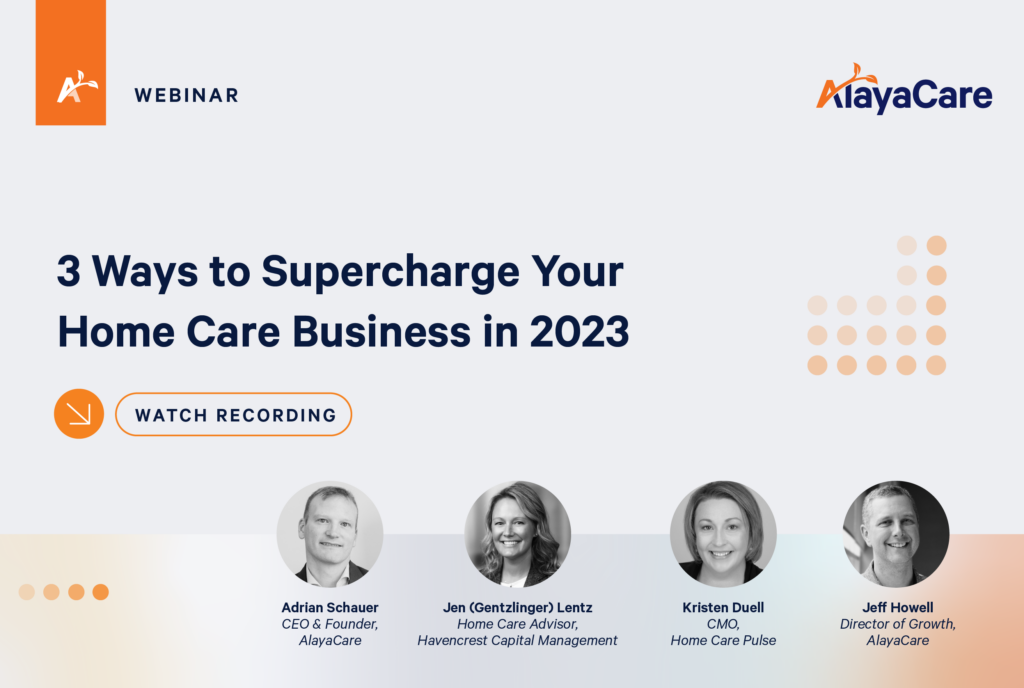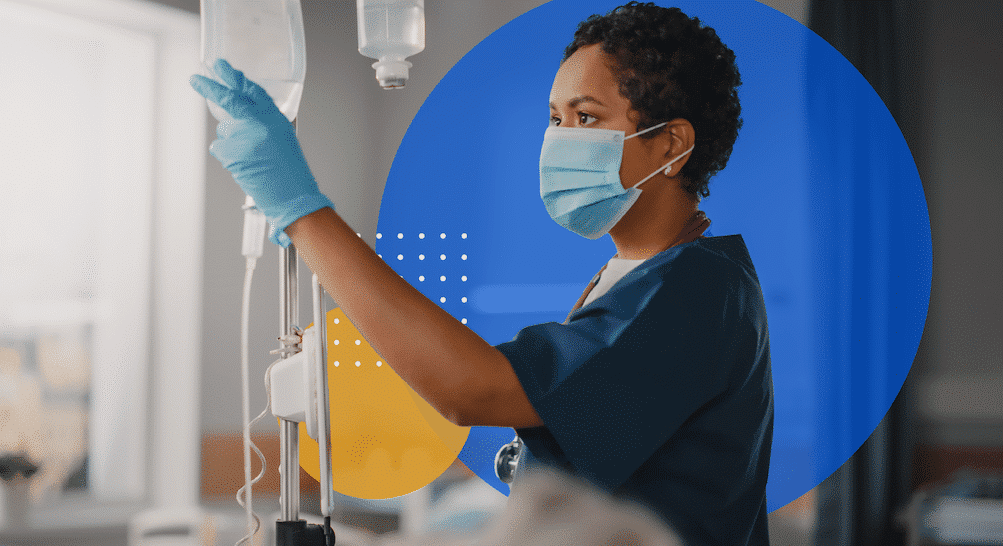Blog
4 ways to improve home care inefficiencies with technology

With the growing demand for home-based care services, organizations are struggling to keep up with repetitive tasks and inefficiencies that can be costly in terms of time and resources. You want your employees in the head office doing only the tasks that involve building a relationship and making decisions. When you look at what’s happening in the back office of the typical home care or home health agency today, you have a lot of activities that don’t involve either of those two things. These mundane activities not only slow down operations but also take away from the quality of care being provided to clients.
Adrian Shauer, CEO of AlayaCare, expressed in episode 35 of the HomeHealth360 podcast, that he believes that this is the year that agencies finally can win the war on repetitive tasks.
There are many options available to you and these solutions can help you learn and execute mundane tasks, which can improve efficiency in your home care organization and focus more time on delivering quality care to your clients.
Here are 4 ways to improve inefficiencies in your home care business with technology.
1. Automate your repetitive tasks and mundane processes
Automation is a game-changer for home care agencies. Using artificial intelligence and robotic process automation (AI and RPA), home care software can streamline processes, automate tedious tasks and save time and money in the long run.
3 ways automation can save your agency time and lower back-office costs over the long term in your home care business:
- Automate intake and scheduling: By automating intake and scheduling processes, home care agencies can reduce the time required to manage patient information, freeing up staff to focus on delivering care.
- Automate billing and revenue cycle management: By automating billing and revenue cycle management processes, home care agencies can help reduce the risk of errors, speed up payment processing times, and improve cash flow.
- Automate documentation and record-keeping: By automating documentation and record-keeping processes, home care agencies can help ensure that patient information is accurate and up to date, reducing the need for manual data entry and reducing the risk of errors.
By reducing the need for manual labor on repetitive tasks and back-office activities, automation can help reduce staffing costs which alleviates some of the stress placed on home care providers so they can focus their time on what matters most: providing patients with quality home care.
“We have moved all of our paper processes in all of our forms into the system, which has dramatically reduced our intake time from 45 minutes to 15, as well as reducing the burden of assessment questions being asked to our clients over and over again”
Emily Hope, Senior Manager, Better Living Health & Community Services
Learn more about automating workflows by reading our blog, Connect apps and automate workflows with AlayaCare Connector.
2. Interoperability and integrations: connect and exchange all your data, applications, and systems with each other seamlessly
With the vast array of automated solutions available today, interoperability (a system to work with other products/systems) and the ability for seamless integration have become increasingly important for home care providers.
With all agencies having unique needs and guidelines, having an automation solution that can easily integrate into a current ecosystem is key. This not only allows for a seamless transition between systems but also creates scalability opportunities to help quickly adjust processes as needs arise.
Along with process integration, easy data exchange helps to ensure information is accurate and up to date across multiple departments or teams. All of this helps to create a more efficient business process automation system for home care.
4 ways interoperability and integrations in home care software can improve business operations:
- Increase operational efficiency: By integrating different systems and allowing for the exchange of data between them, home care agencies can streamline their operations, reduce manual errors and duplications, and increase the speed of processes such as scheduling and documentation.
- Improve patient care: Allows home care agencies to access a comprehensive view of patient information, including medical history, medications, and care plans, which can help to improve the quality of care provided.
- Enhance collaboration: It can improve communication and collaboration between different care providers, enabling them to work together more effectively and coordinate patient care more efficiently.
- Effective data management: Home care agencies can consolidate patient data from multiple sources into one central location, making it easier to access, analyze, and use this data to drive improvements in care.
Here’s a quick checklist to help you check if a home care software provider offers interoperability and integrations:
- Is the software compatible with other systems commonly used in the agency?
- Does the software support data exchange between different systems?
- Does the software allow for centralized data management?
- Does the software support collaboration between different care providers?
- Can the software be customized to meet the unique needs of your agency?
“AlayaCare’s ability to effectively communicate with different software applications has been a huge plus, our clients have the ability to manage their accounts online giving them the freedom to view and pay invoices when it’s convenient.”
Rich Willis, Executive Director of Client Services Lifematters.
Learn more about interoperability and integrations in home care software in our blog Achieving Data Exchange Between Multiple Systems.
3. Optimize your processes and predict patient needs with artificial intelligence (AI) and machine learning
Machine learning is quickly becoming an integral part of home care with automation solutions like artificial intelligence (AI) and robotic process automation (RPA). Machine learning in home care involves the use of algorithms and statistical models to improve the quality of care and the efficiency of care delivery. It can help automate and optimize various tasks, such as predicting patient needs, managing schedules, and analyzing patient data.
3 key benefits of machine learning in home care:
- Enables quick adaptability. These technologies allow machines to learn and execute tasks based on rules. As new data becomes available, machine learning algorithms can be updated to reflect changing trends and patterns in patient behavior, making it easier to improve the quality of care over time.
- Reduces time and resources needed for training and retraining staff. Training and retraining humans, while necessarily important in certain situations, can be costly and time-consuming as it takes away resources from the actual delivery of care. This can be especially important in-home care, where staff turnover can be high and there may be limited resources for training and development. With machine learning, tasks can be automated, and processes can be standardized, reducing the need for extensive training and allowing staff to focus on delivering care.
- Organizations can scale more easily. With machine learning/automation in place, scaling an organization is much more efficient as processes have already been developed and established as they can be easily replicated and expanded, reducing the time and resources needed to manage and maintain operations. This can be especially important in-home care, where the demand for services is rapidly increasing and organizations must find ways to meet this demand while maintaining high standards of quality.
“The agile nature of the platform allows us the flexibility to adjust to any evolution in our care environment. Whether that’s a merger or a pandemic, we can adapt and deploy the technology optimally to enable our clinicians to focus on care and not on administrative technology. The ease of use and scalability lets our clinicians perform at their highest levels.”
Brett Michalak, Chief Information Officer, Option Care Health
Machine learning helps make your whole system more organized and cost-effective, allowing for greater efficiency throughout home care businesses.
Learn more about different AI applications in home care software, here.
4. Use and collect data to make informed decisions and improvements
Data collection and analysis is a powerful tool for optimizing processes in-home care facilities. By leveraging data to identify patterns and trends, organizations can better understand their operations and more effectively manage the challenges of providing quality service. Data collected from patient visits, employee productivity, caregiver technology tool usage, and other areas can be used to identify where inefficiencies exist and develop strategies to address them.
Accurate and up-to-date data is essential for businesses to make informed decisions, as insight derived from it can provide information on current trends and predict future outcomes. As such, clean data is important to ensure that accepted processes are continuing to meet their anticipated standards. 3 examples of types of data to collect and use to make informed decisions and improvements in your agency:
- Use data to measure caregiver performance against goals and identify areas of improvement. Caregiver performance can be tracked in a variety of ways, such as tracking their response time to requests, the number of service requests completed, and client feedback. This data can be used to identify which caregivers are performing better than others and where there is more room for improvement. Additionally, it can provide insight into processes that may need to be streamlined or improved in order to increase efficiency.
- Collect demographic data on clients to tailor services and caregiver-client matching. Demographic data provides valuable insights into a home care agency’s target market and helps them create offerings that meet its unique needs. Collecting demographic data also enables you to match the right caregivers with the right clients by considering factors such as age, gender, cultural background, lifestyle preferences, etc.
- Track client feedback to understand client experiences. Client feedback is critical for understanding how well a home care agency is performing overall. It allows organizations to get an accurate picture of customer satisfaction and identify areas where they may need improvement or areas of exceptional service that should be highlighted. Tracking this feedback also allows agencies to track trends over time so they can make future decisions based on past performance.
In theme with our 3rd tip above, home care organizations can use software with machine learning algorithms and AI to enable smarter decision-making through improved data analysis capabilities. AI can identify user behaviors, predict outcomes and respond to requests quickly, helping organizations stay agile. Predictive analytics enables home care organizations to identify potential problems before they arise, leading to cost savings in the long run.
“In the short time since deployment of AlayaCare, features that have been most impactful to us have been accurate capture of Caregiver compensation data (hours worked, and reimbursable travel time and related mileage). Our costs in these areas have significantly decreased.”
John W. CFO, a quote from Capterra review (Health, Wellness & Fitness Business with 201-500 Employees, used the software for 6-12 months)
Learn more about how you can leverage data for your home care business in our e-guide on How to make the most of your home care data.
“The bad news on the side of the ledger is that margin compression has become such an issue for providers of in-home care that they have no choice but to tackle the overhead costs in their business. Now, the good news is that tools have arrived to finally enable that.”
Adrian Shauer, CEO of AlayaCare
Mundane tasks and inefficiencies not only slow down operations but also take away from the quality of care being provided to clients. There are many technological options available to you such as automating workflows and processes saving both time and money in the long run. AI solutions can aid businesses by learning and executing rules-based tasks quickly and efficiently, while machine learning and integration uphold interoperability unique to each agency’s needs. Clean, accurate data collection is essential to know where improvements need to be made, but with the right tools, organizations can scale much faster.
Interested to learn more about how technology can help improve inefficiencies in your home care organization?
Watch our webinar on 3 ways to supercharge your home care business in 2023.




